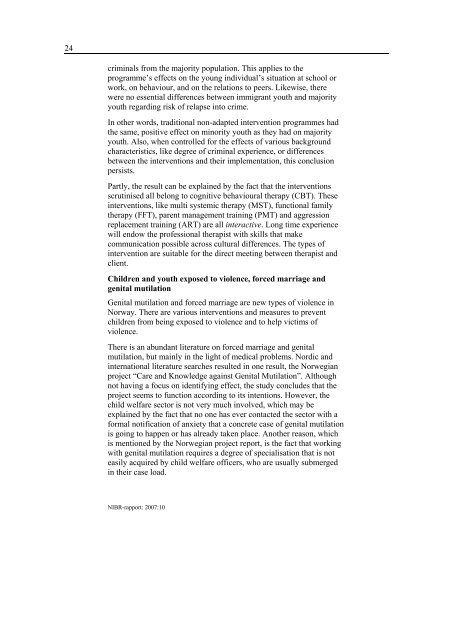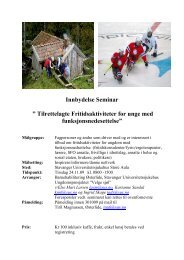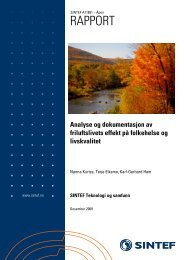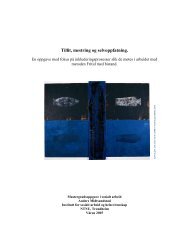- Page 1 and 2: NIBR-rapport 2007:10 Jørn Holm-Han
- Page 3 and 4: Andre publikasjoner fra NIBR: NIBR-
- Page 5 and 6: Tittel: Flerkulturelt barnevern. En
- Page 7 and 8: 2 Innhold Forord ..................
- Page 9 and 10: 4 6.2 Tiltak mens barna fortsatt bo
- Page 11 and 12: 6 11.3.5 Kunnskap om tiltak overfor
- Page 13 and 14: 8 Sammendrag Jørn Holm-Hansen, Tho
- Page 15 and 16: 10 av tolk i barnevernsarbeid. Gjen
- Page 17 and 18: 12 vestlige innvandrere. Foreløpig
- Page 19 and 20: 14 majoritetsbefolkningen. Dette bl
- Page 21 and 22: 16 vestlige innvandrerne, b) opplæ
- Page 23 and 24: 18 Summary and recommendations Jør
- Page 25 and 26: 20 The searches carried out as a ba
- Page 27: 22 Family Group Conferences (FGC) h
- Page 31 and 32: 26 2. The direct meeting between th
- Page 33 and 34: 28 1 Innledning I det daglige barne
- Page 35 and 36: 30 Kapittel 10 presenterer gode fag
- Page 37 and 38: 32 en måte som mest mulig bidrar t
- Page 39 and 40: 34 felles referanseramme. I denne r
- Page 41 and 42: 36 Det essensialistiske begrepet om
- Page 43 and 44: 38 sammen” i disse kategoriene, o
- Page 45 and 46: 40 Refugees in a host society must
- Page 47 and 48: 42 Det foreligger solid dokumentasj
- Page 49 and 50: 44 Tabell 2.1 Trekk ved kollektivis
- Page 51 and 52: 46 majoritetsbefolkningen, øker fa
- Page 53 and 54: 48 I tillegg har det vært gjort fo
- Page 55 and 56: 50 tilpasning, dialog og deltakelse
- Page 57 and 58: 52 om utilsiktede konsekvenser av k
- Page 59 and 60: 54 Det er skrevet mye om nødvendig
- Page 61 and 62: 56 Pflegerls studie er et godt ekse
- Page 63 and 64: 58 Det tiende punktet hos de to for
- Page 65 and 66: 60 barnets livssituasjon henger sam
- Page 67 and 68: 62 utover forvaltningens mål for e
- Page 69 and 70: 64 Tienda argumenterer på samme m
- Page 71 and 72: 66 Seinere litteraturoversikter kon
- Page 73 and 74: 68 partikularisme” (Costa-Lascoux
- Page 75 and 76: 70 En aktivt drøftende og presis b
- Page 77 and 78: 72 etnopsykiatri, psykiatrisk antro
- Page 79 and 80:
74 Tsengs grunnleggende budskap er
- Page 81 and 82:
76 • De terapeutiske følgene (le
- Page 83 and 84:
78 som ”det tradisjonelle”. Tra
- Page 85 and 86:
80 ”raseoppmerksom psykoterapi”
- Page 87 and 88:
82 prototype ved å spørre om pasi
- Page 89 and 90:
84 Kunnskapsoversikten ser også p
- Page 91 and 92:
86 4.3.1 Virkninger: Output og outc
- Page 93 and 94:
88 For både kvalitative og kvantit
- Page 95 and 96:
90 Habilitet Et moment som også er
- Page 97 and 98:
92 tiltak som fungerer overfor etni
- Page 99 and 100:
94 Noe av denne litteraturen er for
- Page 101 and 102:
96 § 1. Tolken skal ikke påta seg
- Page 103 and 104:
98 • Strategier for å sikre at a
- Page 105 and 106:
100 tolking få en viktig plass i e
- Page 107 and 108:
102 lettest mulig med dem. Dette sy
- Page 109 and 110:
104 Chand avslutter med å trekke f
- Page 111 and 112:
106 den metodiske tilnærmingen sv
- Page 113 and 114:
108 For Undersrud er primæroppgave
- Page 115 and 116:
110 om hverandre, ulike forventning
- Page 117 and 118:
112 kulturelle referanserammer hos
- Page 119 and 120:
114 Dette hovedinntrykket blir bekr
- Page 121 and 122:
116 kan være vanskelig å holde de
- Page 123 and 124:
118 faktorer for å skape en god re
- Page 125 and 126:
120 språkferdigheter til kort” (
- Page 127 and 128:
122 ansatte i barnevernet. Basert p
- Page 129 and 130:
124 ansatte og individuelle intervj
- Page 131 and 132:
126 Oversiktsartikkelen er skrevet
- Page 133 and 134:
128 I tillegg kommer relevante stud
- Page 135 and 136:
130 kap.6) 22 . Organisering, innho
- Page 137 and 138:
132 grad når det gjelder deres rel
- Page 139 and 140:
134 rolleavklaring) og ikke minst b
- Page 141 and 142:
136 som er særegne for barnevernsf
- Page 143 and 144:
138 6.1.1 Hva dreier faglitterature
- Page 145 and 146:
140 I presentasjonen av litterature
- Page 147 and 148:
142 Barlow og kolleger viser til at
- Page 149 and 150:
144 Generell litteratur om linkarbe
- Page 151 and 152:
146 I Bydel Alna blir linkarbeidere
- Page 153 and 154:
148 fører til bedre resultater. St
- Page 155 and 156:
150 og direkte nettverksmetoder. De
- Page 157 and 158:
152 en handlingsplan for familien.
- Page 159 and 160:
154 hager, førskoler) skal oppfyll
- Page 161 and 162:
156 andre studier som tyder på at
- Page 163 and 164:
158 henger sammen. Her baserer team
- Page 165 and 166:
160 Artikkelen drøfter først fors
- Page 167 and 168:
162 vi har behandlet i kapittel 6.2
- Page 169 and 170:
164 minimum bachelor-nivå, eller t
- Page 171 and 172:
166 Latin- og afroamerikanske mødr
- Page 173 and 174:
168 kunne nås i løpet av et år.
- Page 175 and 176:
170 til henholdsvis en eksperiment-
- Page 177 and 178:
172 I og med at Ogden et.al. finner
- Page 179 and 180:
174 Ved hjelp av innfløkte, men ty
- Page 181 and 182:
176 fungerte gruppa som en alternat
- Page 183 and 184:
178 variabel, men mekanismene bak f
- Page 185 and 186:
180 er særlig viktig ikke å plass
- Page 187 and 188:
182 Studier av fosterhjemsplasserin
- Page 189 and 190:
184 utbredt i én etnisk gruppe enn
- Page 191 and 192:
186 (Borchgrevink 2002: 34), uten a
- Page 193 and 194:
188 Studie: Ungdommers og foreldres
- Page 195 and 196:
190 ”kliniske realitetene” (det
- Page 197 and 198:
192 informantmaterialet brukes i fl
- Page 199 and 200:
194 år. Den positive identifikasjo
- Page 201 and 202:
196 på andre måter, for eksempel
- Page 203 and 204:
198 De som hevder at det i all hove
- Page 205 and 206:
200 sektoren (child protective serv
- Page 207 and 208:
202 arbeiders kompetanse (Nybell an
- Page 209 and 210:
204 når den i virkeligheten først
- Page 211 and 212:
206 Undersøkelsen av ble foretatt
- Page 213 and 214:
208 1. Øvelser i kulturkompetanse
- Page 215 and 216:
210 Erfaringene med det kulturelt t
- Page 217 and 218:
212 forståelse, ressurser og motiv
- Page 219 and 220:
214 oppfatninger ble belyst. Der de
- Page 221 and 222:
216 blant deltakerne i Familias Uni
- Page 223 and 224:
218 gjort interessante studier knyt
- Page 225 and 226:
220 effekter av tiltak. I materiale
- Page 227 and 228:
222 6.6.2 Kan vi si noe om hva som
- Page 229 and 230:
224 vinkler til hvordan barnevernet
- Page 231 and 232:
226 7 Innvandrerungdom - kriminalit
- Page 233 and 234:
228 forankring. Han hevder at det e
- Page 235 and 236:
230 Familien lukkes for innsyn. Lie
- Page 237 and 238:
232 delinquency intervention progra
- Page 239 and 240:
234 det disse studiene viser er at
- Page 241 and 242:
236 amerikansk gjengforskning, Fred
- Page 243 and 244:
238 Betegnelsen ”arrangerede venn
- Page 245 and 246:
240 goder dannet utgangspunkt for a
- Page 247 and 248:
242 Ett kjennetegn ved guttene var
- Page 249 and 250:
244 Mot slutten av prosjektperioden
- Page 251 and 252:
246 I en Cockrane-review gjennomgå
- Page 253 and 254:
248 den etablerte forvaltningen, i
- Page 255 and 256:
250 Teamet benyttet seg av tre type
- Page 257 and 258:
252 7.6 Rusmidler Ungdom med ikke-n
- Page 259 and 260:
254 alderen for disse personene er
- Page 261 and 262:
256 7.7 Doping Dopingmidler (anabol
- Page 263 and 264:
258 Adolescent Training and Learnin
- Page 265 and 266:
260 ca halvparten av elevene i high
- Page 267 and 268:
262 knyttet til kroppsbygging i kom
- Page 269 and 270:
264 landet viste at fram til fylte
- Page 271 and 272:
266 Vold i minoritetsfamilier Som n
- Page 273 and 274:
268 Barn som ser eller hører at fo
- Page 275 and 276:
270 medarbeidere i familievernet, b
- Page 277 and 278:
272 USA og Canada Graham-Bermann og
- Page 279 and 280:
274 Jaffe konkluderer på samme må
- Page 281 and 282:
276 studium om yrkesveiledning i et
- Page 283 and 284:
278 Dette gjelder menn i større gr
- Page 285 and 286:
280 problematikken med kjønnslemle
- Page 287 and 288:
282 en arbeidsgruppe nedsatt av bri
- Page 289 and 290:
284 hadde arbeidet mest med spørsm
- Page 291 and 292:
286 kriterier de er forskjellige n
- Page 293 and 294:
288 For å holde oss til metoder, t
- Page 295 and 296:
290 Dette er selvsagt ikke en uttø
- Page 297 and 298:
292 velutviklet velferdsapparat enn
- Page 299 and 300:
294 heleid av Universitetet i Oslo.
- Page 301 and 302:
296 11 Konklusjoner og anbefalinger
- Page 303 and 304:
298 Et snevert etnisk kulturfokus k
- Page 305 and 306:
300 observasjoner som ligger til gr
- Page 307 and 308:
302 Det er samtidig et svært inter
- Page 309 and 310:
304 11.3.3 Kunnskap om tiltak der b
- Page 311 and 312:
306 Også mer prinsipielle innvendi
- Page 313 and 314:
308 Andre studier (se Miranda et al
- Page 315 and 316:
310 utsatt for vold i nære relasjo
- Page 317 and 318:
312 fokus på kultur kan føre til
- Page 319 and 320:
314 samfunnsvitere med metodekompet
- Page 321 and 322:
316 utvilsomt sosialantropologien k
- Page 323 and 324:
318 barnevernets generelle kompetan
- Page 325 and 326:
320 drug treatment services for His
- Page 327 and 328:
322 Betancourt, J. R., A. R. Green,
- Page 329 and 330:
324 Carlsson, Y. (2006). Hvordan gr
- Page 331 and 332:
326 Dent, C. W., S. Sussman, et al.
- Page 333 and 334:
328 Farmer, E. and M. Owen (1995).
- Page 335 and 336:
330 Gordon, E. (1997). Introduction
- Page 337 and 338:
332 Hanssen, I. (2005). Helsearbeid
- Page 339 and 340:
334 Jakobsen, M. B., J. A. Thomsen,
- Page 341 and 342:
336 Landenberger, N. and M. W. Lips
- Page 343 and 344:
338 Maroševic, Z. (2005). Rådgivn
- Page 345 and 346:
340 minoriteters møte med politi o
- Page 347 and 348:
342 Prieur, A. og L. S. Henriksen (
- Page 349 and 350:
344 Sherraden, M. S. and R. E. Barr
- Page 351 and 352:
346 Torgersen, L. (2005). Betydning
- Page 353 and 354:
348 Øia, T. (2003). Innvandrerungd
- Page 355 and 356:
350 Familiearbeid og (fleretnisk? e
- Page 357 and 358:
352 Invandrare tolk (11 treff) Mån
- Page 359 and 360:
354 (international child developmen
- Page 361 and 362:
356 Migrantenfamilien und Integrati
- Page 363 and 364:
358 Publications - Reviews and bibl
- Page 365 and 366:
360 Vedlegg 2 Forskjeller mellom mi
- Page 367 and 368:
362 I familier uten innvandrerbakgr
- Page 369 and 370:
364 likebehandling mellom gruppene,
- Page 371 and 372:
366 • I hvilken grad og på hvilk
- Page 373 and 374:
368 samiske befolkningen i Nord-Nor






